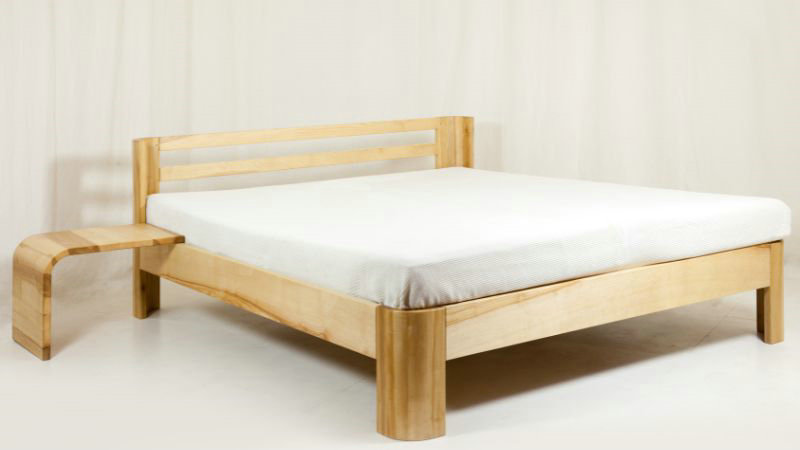
When shopping for a wooden bed frame, one important consideration is how much weight it can safely support. The maximum weight capacity of a wooden bed frame depends on several key factors, including the type and quality of wood used, the thickness of the slats or platform, the spacing between the slats, and the overall design and construction of the frame.
A bed frame needs to be strong enough to hold the weight of the mattress as well as the people sleeping on it night after night. Exceeding the weight limit can cause a wooden frame to sag, creak, warp or even break over time. Understanding the factors that determine a wooden bed’s load-bearing ability is essential for choosing a frame that will provide sturdy, lasting support.
This article will take an in-depth look at the various elements that impact how much weight a wooden bed frame can hold. We’ll explore the role that wood type, slat thickness and gap width, and structural reinforcement play in a frame’s total weight capacity. Armed with this knowledge, you’ll be well-equipped to select a wooden bed frame that can comfortably handle the demands placed on it, ensuring many years of restful sleep.
What is a Bed Frame?
A bed frame can support a mattress and elevate it off the floor. It typically consists of a headboard, footboard, side rails, slats, or a platform to hold the mattress. Bed frames come in various styles, materials, and sizes to suit different preferences and needs.
How Much Weight Can a Wood Bed Frame Hold?
While 500-600 lbs is a common maximum for wooden beds, the weight capacity of a bed includes the weight of your mattress and yourself, which varies considerably based on materials and construction. Thicker hardwood, narrowly spaced slats, and robust joinery allow some frames to support 1000 lbs or more. Consulting manufacturer specifications is the best way to determine a specific bed’s limits.
Typical Weight Capacities of Wooden Bed
- Standard wooden bed frames are designed for average individuals and can usually support 500-600 lbs total, accounting for the sleepers and the mattress.
- Beds with wooden slats typically have a maximum capacity of around 500 lbs total and 350 lbs per person.
- Heavy-duty wooden beds with extra thick slats and robust construction may support 800-1000 lbs or more in total.
- Some premium solid wood platform beds claim weight capacities up to 2000 lbs per sleeping platform.
- Plywood slats generally have a lower weight threshold than solid wood slats of the same thickness.
Standard Weight Limits for Different Bed Sizes
- Twin Size: Generally holds up to 250 pounds.
- Full Size: Can often hold up to 500 pounds.
- Queen Size: Typically supports up to 600 pounds.
- King Size: Designed to hold up to 500-1,000 pounds, depending on the construction and materials used.
What are the Factors Influencing Wooden Bed Weight Limits?

There are several factors that contribute to the weight capacity of a wooden bed frame. When choosing a wooden bed frame, your focus should be on the type of wood, construction quality, and care needed. These factors are key to ensuring that the bed frame is both strong and long-lasting.
Type and quality of wood used: Hardwoods like oak, maple, cherry, and ash are durable materials that are more suitable for bed frames due to their inherent strength and durability compared to softwoods.
- Pine: It’s affordable and fairly sturdy.
- Oak: Known for its strength, oak can support more weight.
- Maple: Durable and robust, maple is excellent for heavy use.
- Cherry: Not only strong but also visually appealing.
Thickness of the slats or platform: Thicker slats are generally more robust and can handle more weight without sagging. The thickness contributes to the slats’ overall strength and stability. Plywood used for bed frames should be at least 1″ thick to provide adequate support and avoid mattress flex between the slats.
Spacing between the bed slats: Slats should be spaced no more than 2.75 to 3 inches apart for optimal mattress support. Wider spacing between slats can lead to mattress sagging and reduced weight capacity.
Overall design and construction of the frame: The design of the wooden frame, including the presence of additional support features like center rails and legs, reinforced corners, and well-constructed joints, plays a crucial role in its durability and weight capacity. Frames with more closely spaced slats and additional structural reinforcement can generally hold more weight.
Quality construction and joints: The way your bed frame is put together makes a big difference. Key aspects include:
- Joints: Dovetail or mortise-and-tenon joints add strength.
- Reinforcement: Additional supports or thicker rails increase weight capacity.
- Quality Check: Make sure there are no gaps in the joints and that everything feels tight and secure.
Frequency of movement and usage: The more a bed frame is moved, disassembled, or subjected to dynamic forces (like jumping on the bed), the greater the chance of wear and tear, which can impact its long-term weight capacity.
Taking care of your bed frame can greatly extend its life:
- Avoid excessive moisture which can weaken the wood.
- Regularly check and tighten any loose bolts or screws.
- Support slats with a center rail if the bed is wider than a twin.
Other Bed Frame Weight Capacities
When you’re looking for a new bed frame, it is important to consider the differences between frame types, and the benefits they offer can be a big help in making your choice.
Metal Bed Frames
- Metal frames often have higher weight capacities than wooden frames due to the strength of the material.
- Many standard metal frames can support 1000-2000 lbs or more.
- Some heavy-duty metal frames are rated for even higher capacities, such as 5 tons (10,000 lbs).
Platform Bed Frames
- Weight capacity varies based on the material (wood or metal) and construction.
- Well-constructed platform beds can typically support 500-1000 lbs.
Adjustable Bed Frames
- Adjustable frames generally have a lower weight capacity than standard frames due to the motorized components.
- Many adjustable frames can support 600-850 lbs, but it’s important to check the specific model.
Difference Between Platform and Box Spring Frames

Platform bed frames are designed with a solid or slatted base to support your mattress without the need for a box spring. This type of frame offers a sleek, modern look and suits various mattress types, including memory foam and latex. On the other hand, box spring frames rely on a box spring to provide support and enhance the mattress’s lifespan. These frames can add extra bounce and are often used with innerspring mattresses.
| Feature | Platform Frame | Box Spring Frame |
|---|---|---|
| Mattress Support | Increased support for the mattress | Enhanced mattress support and comfort |
| Design | Sleek design, often lower to the ground | Higher profile, which may not be ideal for all room designs |
| Durability | Can be more durable due to fewer moving parts | – |
| Shock Absorption | Limited shock absorption compared to box springs | Absorbs shock, reducing wear on the mattress |
| Mattress Life | – | May extend the life of your mattress |
| Firmness | Typically firmer, which may not suit all sleep preferences | – |
| Cost | – | Additional cost for the box spring |
Pros and Cons of Adjustable and Upholstered Frames
Adjustable bed frames give you the flexibility to change the position of your bed, ideal for reading, watching TV, or relieving certain health issues. They can be a good choice if you need this adaptability. However, they may be costlier and require compatible mattresses.
| Pros | Cons |
|---|---|
| Provides relief from pain, including back problems, arthritis, and neck issues. | Higher cost compared to standard bed frames. |
| Allows for customizable positions for enhanced comfort while sleeping, reading, or watching TV. | Can be heavy and difficult to move. |
| May help with health concerns like acid reflux, snoring, asthma, and circulation problems. | May require a specific type of mattress for compatibility. |
| Offers convenience features such as massage options and under-bed lighting. | Potential for mechanical failures and need for maintenance due to moving parts and electronics. |
| Allows for independence and can assist with getting in and out of bed. | Can be noisy due to motors and adjusting mechanisms. |
Upholstered bed frames add a touch of elegance and come in a variety of materials and colors. They can bring warmth and comfort to your bedroom but may require more maintenance to keep the fabric looking new.
| Pros | Cons |
|---|---|
| Provides a soft, cushioned surface for added comfort. | Can be more expensive than wooden or metal bed frames. |
| Offers a luxurious and cozy appearance, enhancing bedroom decor. | Fabric may be prone to staining, wear and tear over time. |
| Available in a wide range of colors, fabrics, and styles to suit personal preferences. | May not be suitable for households with pets due to risk of scratching or tearing. |
| Can help regulate temperature with insulating properties. | Can be more difficult to keep clean compared to wood or metal frames. |
| Often easier to assemble than other bed frame types. | Fabric choices may go out of style more quickly than timeless wood or metal options. |
Frequently Asked Questions
What’s the average weight limit for bed frames?
Most bed frames have an average weight limit of 500 pounds, but this can vary based on the materials used and the frame’s construction.
Can a single bed accommodate heavy weights?
Single beds, while smaller, are still made to support a substantial amount of weight, and many can hold up to 500 pounds.
What are the best bed base options for heavier individuals?
For those requiring a bed to support higher weights, heavy-duty steel or reinforced wooden bed frames are the best options, with some models having the capacity to hold from 1,000 to even 5,000 pounds.
How to maintain the longevity of a wooden bed?
By regular cleaning, protecting from environmental factors, proper usage and maintenance, addressing repairs, and investing in quality materials, you can maintain the longevity of your bed frame. With proper care, a well-constructed solid wood bed can last for decades.






